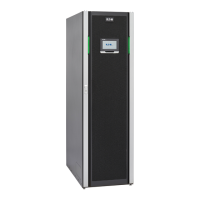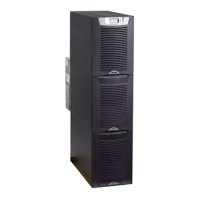Eaton® 9390 (100–160 kVA) UPS Installation and Operation Manual 164201604—Rev F 116
The rectifier and inverter turn on. When the inverter reaches full voltage, the UPM synchronizes with the
output and closes output contactor K3. The UPM is online and in Normal mode with the NNOORRMMAALL status
indicator illuminated and in parallel with the other system UPMs.
9. Close battery breakers for the UPM any time after INVERTER SYNCING or CLOSE BATTERY appears on
the display.
99..22..77 PPaarraalllleell SSyysstteemm aanndd CCrriittiiccaall LLooaadd SShhuuttddoowwnn
To perform maintenance or service on the critical load, shut down power to the load by performing the
following procedure:
Using the following procedure removes all output from the critical load. You should use this procedure only
when you need to de–energize both the parallel system and the critical load.
1. Turn off all equipment that is being powered by the parallel system.
2. Press the CCOONNTTRROOLLSS pushbutton on the main menu bar on any UPM. The System Controls screen
appears.
3. Press the BBYYPPAASSSS pushbutton on the System Controls menu bar of any UPM.
The UPMs transfer to Bypass mode.
4. Press the
USING THE CONTROL PANEL
Eaton 9390 UPS (20–80 kVA) and 9390IT (20-40 kVA) Installation and Operation Manual S 164201603 Rev 4
8-15
Select TIME INTERVAL MONITORED from the Current kW Demand Log Setup screen 2
menu to display the Time Interval Monitored Setup screen. The Time Interval
Monitored Setup screen allows the time duration of the event being monitored to be
changed. Figure 8‐17 shows the Time Interval Monitored Setup screen.
Use the
or pushbuttons to select the character position. Use the or
pushbuttons to change the character value. Once the new value is entered, press the
DONE pushbutton. The Time Interval Monitored Setup Save screen is displayed.
0000
DONE
TIME INTERVAL MONITORED SETUP
Figure 8‐17. Time Interval Monitored Setup Screen
The Time Interval Monitored Setup Save screen lets you save the new time interval,
retry another time interval, or abort the change. Figure 8‐18 shows the Time Interval
Monitored Setup Save screen.
Press SAVE, RETRY, or ABORT. If SAVE or ABORT is pressed, the action is completed,
and the Current kW Demand Log Setup screen 2 displays. If RETRY is pressed, the
Time Interval Monitored Setup screen is redisplayed.
ABORT
SAVE RETRY
0000
TIME INTERVAL MONITORED SETUP
Figure 8‐18. Time Interval Monitored Setup Save Screen
pushbutton to display System Controls Screen 2.
5. Press the PPMM OOFFFF pushbutton on the System Controls menu bar.
The power module (PM) status indicates SHUTDOWN. The input and output contactors open, the battery
breaker or disconnect is tripped, and the power module is turned off. The bypass source supplies the
critical load.
6. Repeat Step 2, Step 4, and Step 5 for each UPM, except the last UPM.
7. To shut down the last UPM, press the REPO pushbutton switch (see
9.2.9 Using the Parallel System Remote Emergency Power-off Switch).
The input, output, and bypass backfeed contactors open, the battery breaker or disconnect is tripped, and
the power module is turned off immediately, without asking for verification.
8. Open all UPM input and bypass (if dual feed) feeder circuit breakers.
The parallel system and critical load is now de–energized.
9. To restart the parallel system after using the REPO pushbutton , reset the REPO switch and then follow
the procedure in 9.2.1 Starting the Parallel System in Normal Mode or
9.2.2 Starting the Parallel System in Bypass Mode.
99..22..88 UUssiinngg tthhee UUPPSS LLOOAADD OOFFFF PPuusshhbbuuttttoonn
NNOOTTEE The UPM LOAD OFF pushbutton controls only the UPM on which Load Off was
activated and only interrupts the ability of that module to deliver power to the critical
bus. The redundant modules continue to support the critical load. The UPM can be shut
down only if the remaining UPMs can support the critical load without being overloaded.
To remove all power from the critical load, use the REPO pushbutton.
A UPS Load Off is initiated by the LLOOAADD OOFFFF pushbutton from the main menu bar or the System Controls
menu bar. The UPS LLOOAADD OOFFFF pushbutton de–energizes the critical load and powers down the UPS.
The UPS (including Bypass) remains off until restarted.
UPS Operating Instructions

